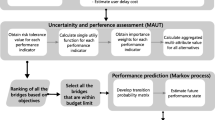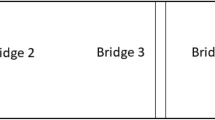Abstract
Recently, social interest in the deteriorated bridges and infrastructure has been increasing. Also, studies on performance prediction and maintenance decision making of structures are underway. In this study, it was proposed an algorithm to create an optimal maintenance scenario that takes into consideration the relationship between the members of bridge that affect each other, rather than the conventional maintenance that is focused on single members of the bridge.
Since maintenance scenario creation is discrete in terms of time and cost. So in this study, it is used a genetic algorithm. Each member of bridge has a subordinate relation that takes into account member damage transitions effect and the elimination of duplication maintenance cost, which was established through the Korean bridge maintenance manual and expert opinion. In order to predict the performance change of each member, the algorithm used the condition prediction model of each member of the bridge, which was created by multiple regression analysis based on the actual bridge case. Also, it used the maintenance cost model of members for cost estimation, it has created and applied it through actual maintenance case analysis. The constraint of the algorithm is set to the minimum maintenance level of the bridge by the bridge administrator. And, it was conducted the case study about real bridge model using the optimal maintenance model, analyzed the cost-effect and made maintenance scenario.
Access provided by Autonomous University of Puebla. Download conference paper PDF
Similar content being viewed by others
Keywords
1 Introduction
Recently, interest in preventive maintenance of bridges and infrastructure has increased, and research has been conducted on the performance of structures and maintenance costs [1,2,3,−4]. After collecting the safety inspection and in-depth inspection data of the national road bridges, the condition prediction model was established through polynomial regression analysis considering the deterioration rates [5]. In order to make these studies practical, optimization algorithms were proposed to take account of the various constraints and correlations between members.
2 The Optimal Maintenance Algorithm for Time and Costs
To optimize time point and cost for maintenance are required to satisfy correlation in each member and various constraints. And then, a genetic algorithm has some effective advantages to estimate various variables and constraints. So, in this study, there is suggested the model to predict optimal time point and cost for bridge maintenance, using a genetic algorithm(G,A).
2.1 The Prediction Model of Bridge Member Condition and the Maintenance Cost
The prediction model of bridge member condition is made to forecast each member condition rate up to the target life of the bridge. And this model is based on safety inspection and in-depth inspection data of the national road bridges in Korea since 1995. In Fig. 1, the condition prediction model was developed by polynomial regression results which were based on bridge condition ratings, and the difference in the degree of deterioration expressed the deterioration ratio in the point of maintenance before and before after.
The rating maintenance cost function was proposed by specialists’ opinions and maintenance rating cost data, and it was shown that the curve was newly updated by rating resulting from maintenance.
2.2 Optimization Model Using the Genetic Algorithm
The genetic algorithm (G.A.) is suitable as maintenance optimization methods because they do not have to be constrained by differential and continuous conditions in the purpose function. So, in this study, it was applied to. Figure 2 is described in the genetic algorithm for the absence-specific correlation and constraints.
Each Member of the bridge is needed to consider the correlation with the increased deterioration ratio. When it was reached condition-index Grade D(0.3), it has to replace as the maintenance and resets as the initial deterioration ratio(a). At this time, it should be considered some relationship with each member and decided to main or sub-member. Then, it is calculated the cost of bridge maintenance using relationship about bridge members.
3 Case Study of Optimal Algorithm About Maintenance Time Point and Cost
In this study, to confirm the applicated performance ability about the optimal algorithm, it conducts a case study using by deck and pavement members of the common bridge in Korea. As shown from the Table 1, it is represented factors - the deterioration ratio, deterioration increase ratio, C.I.- Cost function, and constraints. Each factor is set into the algorithm and calculates the optimal time point and cost of maintenance. And then, it makes the maintenance scenarios with the member-specific correlation. The deck and pavement maintenance scenario of Fig. 3 is represented the optimal maintenance scenario considering the member-specific correlation and scale for the target life of 100 years.
4 Conclusions
In this study, to optimize time point and cost for maintenance, there is suggested the model to predict optimal time point and cost for bridge maintenance. Then, it is represented the optimal algorithm about maintenance of bridge using and genetic algorithm.
This algorithm can establish an optimal maintenance scenario considering correlation about each member of bridge to maintenance efficiently and reasonably. In addition, it is expected to be able to further apply a variety of member-specific correlations.
References
Mohan A, Poobal S (2018) Crack detection using image processing: a critical review and analysis. Alexandria Eng J 57(2):787–798
Korea Agency for Technology Infrastructure Advancement (KAIA) (2013) Bridge life-span extension using ICT, partial replacement and low-carbon materials
Ministry of Land, Infrastructure and Transport (2014) Korea Infrastructure Safety Corporation, Bridge Maintenance Manual
Ministry of Land, Transport and Maritime Affairs (2012) Z Developing Bridge Management System Considering Life-Cycle Cost and Performance of Bridges
Lee JH, Lee KY, Ahn SM, Kong JS (2018) Proposal of maintenance scenario and feasibility analysis of bridge inspection using bayesian approach. J Korean Soc Civil Eng 38(4):505–516
Acknowledgements
This research was supported by a grant (17SCIP-B128492-01) from Smart Civil Infrastructure Research Program funded by Ministry of Land, Infrastructure and Transport of Korean Government.
Author information
Authors and Affiliations
Corresponding author
Editor information
Editors and Affiliations
Rights and permissions
Copyright information
© 2021 Springer Nature Singapore Pte Ltd.
About this paper
Cite this paper
Jin, S., Lee, J.H., Choi, Y., Lim, J., Kong, J.S. (2021). Optimal Bridge Maintenance Algorithms Considering Subordinate Relation with Bridge Members. In: Wang, C.M., Dao, V., Kitipornchai, S. (eds) EASEC16. Lecture Notes in Civil Engineering, vol 101. Springer, Singapore. https://doi.org/10.1007/978-981-15-8079-6_116
Download citation
DOI: https://doi.org/10.1007/978-981-15-8079-6_116
Published:
Publisher Name: Springer, Singapore
Print ISBN: 978-981-15-8078-9
Online ISBN: 978-981-15-8079-6
eBook Packages: EngineeringEngineering (R0)







